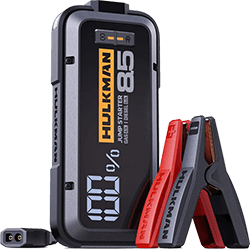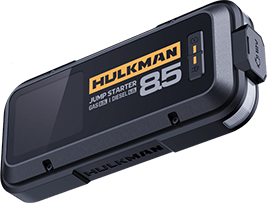Recent Articles
-
Mapping America’s Solar Landscape: Regional and Seasonal Variations November 11, 2025
-
Why Solva Solar Panels Stand Out: From Consumer’s Comment November 06, 2025
-
Unleashing Solar Power: Tips for Using and Maintaining Portable Solar Panels November 03, 2025
Featured Products
note
Understanding Portable Power Station Ports
Portable power stations look similar on the outside, but the real difference lies in their ports. Each type of output and input interface determines what devices you can power, how efficiently you can recharge, and whether sensitive electronics stay safe. For professional users—like photographers, field researchers, content creators, and remote workers—the stability, waveform quality, and switching response of these ports can make or break a job.
This blog explains the main types of output and input ports on portable power stations, how they differ, and why models with pure sine wave and fast UPS capabilities offer a serious advantage. The Hulkman Mega power station is used as the primary example, especially for scenarios involving cameras, telescopes, scientific sensors, laptops, and precision electronics.
In this article, we’ll cover:
- Core Output Ports: DC, USB, and AC
- Input Ports: AC Charging, Car Charging, and Solar Charging
- Hulkman Mega: Precision Power for Sensitive Devices
- UPS Mode and Zero-Interruption Protection
- Outdoor Use and Energy Management
- Why Port Stability and Power Quality Matter
- Choosing the Right Station for Precision Equipment
- Final Take
Core Output Ports: DC, USB, and AC
Every portable power station relies on three major output categories: DC, USB, and AC. They don’t replace one another — they cover different voltage needs and device types.
DC outputs are designed for low-voltage devices. A standard DC 5521 port typically delivers 12V–15V at around 2A–3A (up to roughly 45W). These ports power LED camping lights, small car fridges under 20L, routers, or security cameras. Another common DC output is the car charger-style socket (12V–14V, up to 150W), useful for inflators, coolers, portable rice cookers, and dash cams. DC power is steady and precise, protecting sensitive circuits, but it can’t handle high-watt appliances.
USB outputs focus on digital devices. USB-C ports with PD (30–100W) can charge laptops, drones, tablets, and mirrorless cameras at high speed. Many lightweight laptops and pro cameras now rely on this standard. USB-A ports (typically 10–18W with QC protocols) serve phones, headsets, smartwatches, and action cams. They’re plug-and-play but not made for household appliances.
AC outputs deliver the same kind of power you get from wall sockets—110V or 220V depending on region. Typical portable units offer 300W–1000W and 2–3 outlets. That’s enough to run kettles, coffee machines, small microwaves, drills, printers, or small ovens. Some stations allow short bursts of double power for startup loads. However, not all AC outputs deliver clean current: waveform quality is the main dividing line between basic and professional-grade models.
Input Ports: AC Charging, Car Charging, and Solar Charging
Input ports decide how you refill the battery and how flexible a power station is across different environments.
AC wall charging is the fastest and simplest. Many models charge at 100–600W, which means a 1000Wh unit can recharge in 1.5–5 hours. The tradeoff is that you need indoor power access.
Car charging uses 12V or 24V vehicle sockets at 50–120W. It’s slower—often 8–12 hours for the same 1000Wh—but useful during road trips or emergencies.
Solar charging (100–400W) works with compatible panels and is essential for off-grid work, camping, RV travel, and field research. On sunny days, you can refill a medium-size power station in 3–6 hours. It offers independence but depends heavily on daylight and panel capacity.
Most modern portable power stations include at least two input options. The Hulkman Mega supports high-speed AC charging, vehicle charging, and up to 400W solar input, making it suitable for both indoor and remote professional use.
Hulkman Mega: Precision Power for Sensitive Devices
Professional equipment—like telescopes, 3D scanners, servers, drones, or high-end cameras—requires clean, stable, and uninterrupted energy. Hulkman Mega is built specifically for these needs, combining pure sine wave AC output, UPS backup with ≤15ms switch time, and multiple stable USB-C PD ports.
Its pure sine wave AC output matches household power quality, eliminating the harmonic distortion found in simplified or modified sine wave units. This matters because wave interference can cause system errors, misreadings, or long-term component damage.
A user in the Cloudy Nights astronomy forum described a mount malfunction tied to power from a non–sine wave inverter, reinforcing the risk of waveform distortion.(cloudynights.com)
Hulkman Mega provides 600W continuous AC power and up to 1200W in Turbo Mode for short surges. This supports equipment like laser printers, compact refrigerators, CPAPs, small lab instruments, and telescope mounts, while protecting components from spikes and drop-offs.
On the USB side, two USB-C ports delivering 65W and 100W PD can charge laptops, cameras, and drones without extra adapters. Two USB-A ports offer fast charging for microphones, action cams, and external drives.
UPS Mode and Zero-Interruption Protection
A critical difference between consumer-grade power banks and professional stations is UPS (Uninterruptible Power Supply) capability. Hulkman Mega’s UPS mode switches from wall power to battery in ≤15 milliseconds—well below the 100ms tolerance limit of most cameras, monitors, and mini servers.
This is vital during indoor shooting, office use, or observatory work. Even a split-second blackout can damage files or stop data collection. The device also features Bypass Mode, which routes wall power directly to devices without draining the battery during long stationary sessions.
Academic research on power quality in sensitive electronics has shown that waveform distortion contributes to overheating and circuit irregularity in precision tools.(IEEE Xplore)
Outdoor Use and Energy Management
For astronomy, documentary shoots, or geological surveys, energy conservation makes a significant impact. Hulkman Mega includes an Eco Saving Mode that shuts off idle ports, cutting standby drain nearly in half. A 1000Wh unit can power a camera and telescope mount for 12–15 hours overnight under this mode, preserving operational stability without circuit noise.
Solar recharging gives field teams a backup plan. With 400W solar input, the unit can refill during daytime for another full night of observation. DC car charging adds flexibility during travel.
Why Port Stability and Power Quality Matter
Power ports aren’t just about compatibility—they influence lifespan, data safety, and user cost. Many cheap power stations overlook waveform quality, surge behavior, and thermal stability. Modified or stepped sine wave outputs can cause coil whine, flickering, or device shutdowns.
A Reddit discussion among campers and electronics hobbyists highlights multiple accounts of hard drive and router failures tied to cheaper portable inverters lacking pure sine output.(Reddit)
Hulkman Mega avoids these issues by delivering AC output with ±1% voltage precision and consistent sinusoidal current. Fast, protocol-based USB-C power delivery ensures mobile devices avoid overcharging, overheating, or undervoltage slowdowns.
Choosing the Right Station for Precision Equipment
When selecting a portable power station for cameras, laptops, telescopes, scientific sensors, or studio lights, four features matter most:
- Supply waveform quality (pure sine wave over modified types)
- UPS switching speed (under 20ms, ideally under 15ms)
- Output accuracy and voltage stability
- Flexible input/output port configuration
Hulkman Mega meets these demands with three pure sine AC outlets, dual USB-C PD ports, dual USB-A, DC car output, DC5521, and triple input recharge methods. It’s not just about wattage—the clean electricity and fast failover protect sensitive digital devices and reduce long-term risk.
Final Take
Portable power stations are not interchangeable. The port layout, waveform type, recharge methods, and switching time define whether a device is merely convenient or truly professional-grade. DC ports handle small appliances, USB ports handle smart devices, and AC ports power heavier loads—but only sine wave AC ensures component safety.
Hulkman Mega integrates stable output, clean sine wave current, ≤15ms UPS switching, high-precision USB-C, and multi-scene charging (AC, solar, and car). That combination makes it ideal for users who rely on mission-critical electronics—from astrophotography and field science to mobile workstations and production gear.
Learn more and use exclusive code hidden in Hulkman social media to get Mega discount at checkout.






















